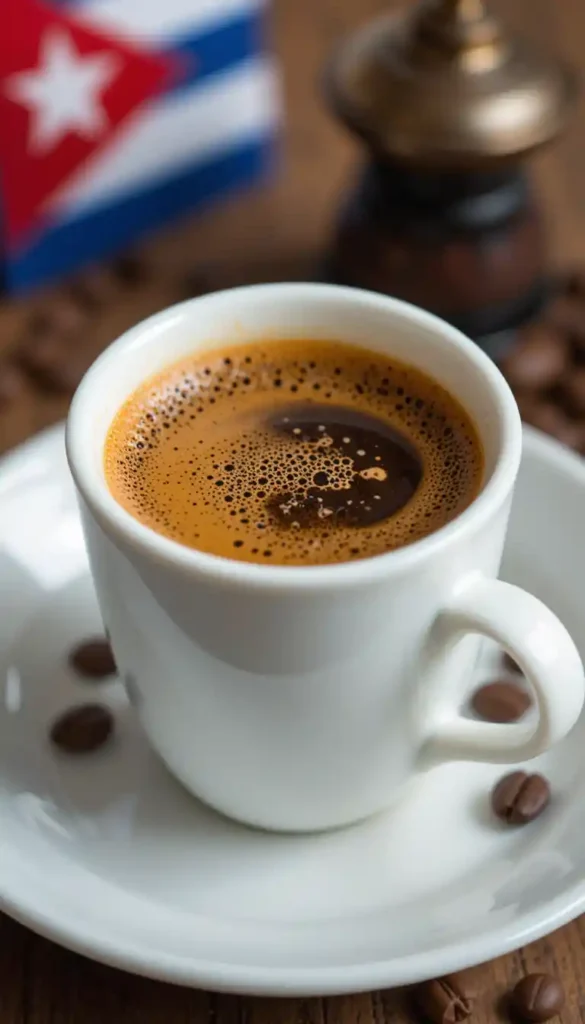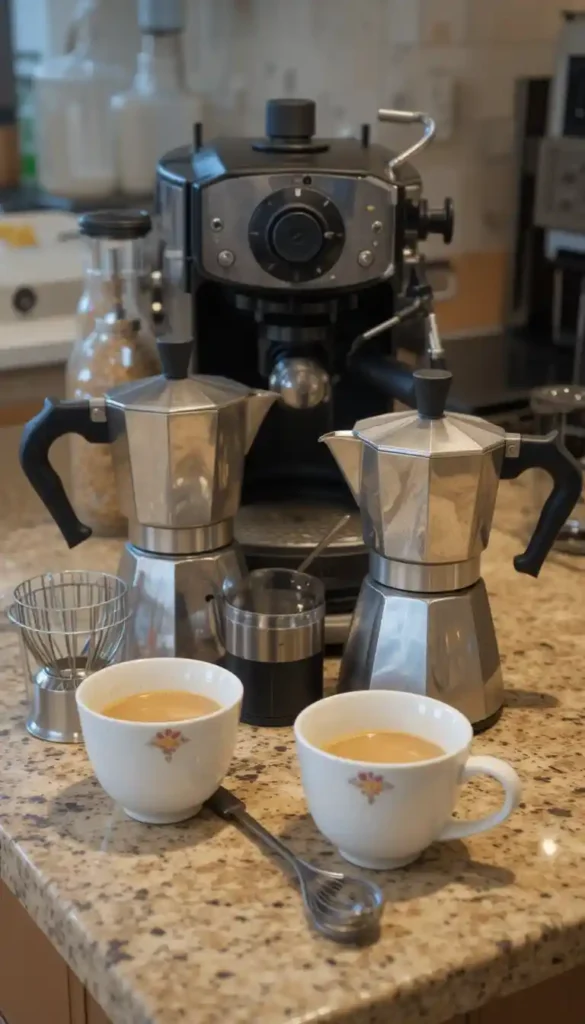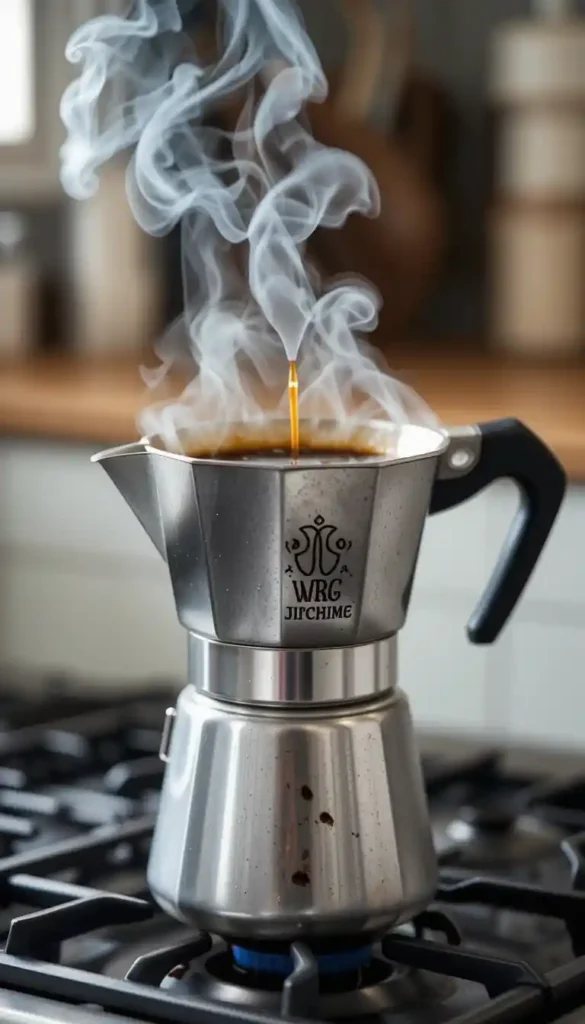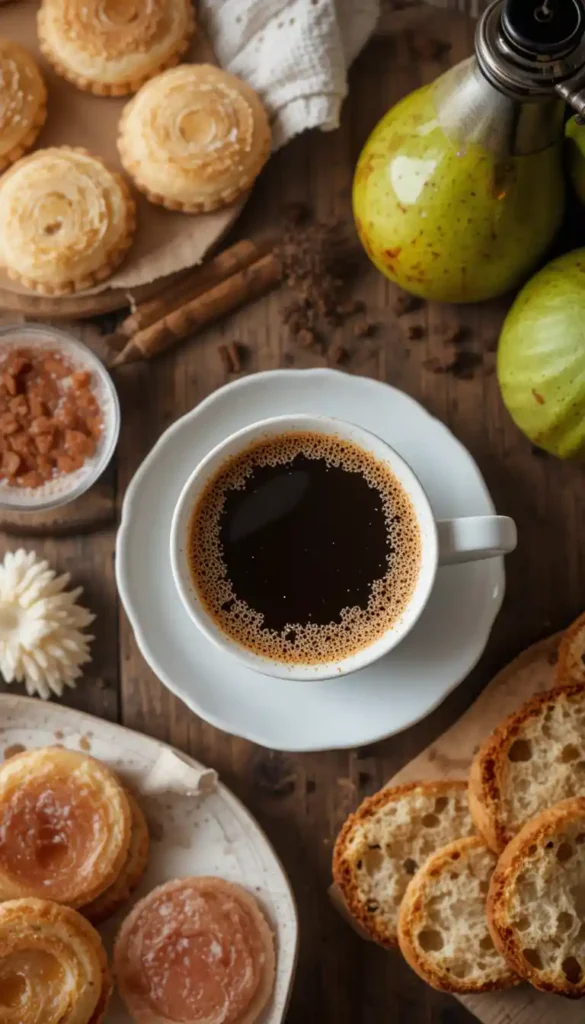Cubano Coffee Guide 🔥 What Makes It So Special?
Table of Contents
Table of Contents
Have you ever found yourself longing for that distinctive, bold flavor of a true Cubano coffee after experiencing it in a café? The first time I experienced the rich intensity of authentic Cuban coffee, I was standing in a small café in Miami’s Little Havana. The strong aroma, sweet crema, and powerful flavor created an unforgettable moment that I’ve spent years trying to recreate in my kitchen.

The good news? You can achieve that same delicious experience at home. With the right ingredients, equipment, and technique, that perfect cup of Cubano coffee is within your reach—no plane ticket to Miami required.
In this guide, I’ll share everything I’ve learned about making restaurant-quality Cubano coffee right in your kitchen—no specialized equipment required. From selecting the right beans to mastering the essential “espuma” (that signature sweet foam top), you’ll soon be brewing coffee that rivals any Cuban café.
What Makes Cubano Coffee Unique?
Before diving into the preparation, let’s understand what sets Cubano coffee apart from your regular morning brew.
Cubano coffee (also called Café Cubano or Cuban espresso) is much more than just strong coffee. It’s a cultural institution with a rich history dating back to when Cuba was one of the world’s leading coffee exporters. What distinguishes it is the unique combination of dark-roasted espresso and the signature sweet foam called “espuma” that sits atop the drink.
Unlike Italian espresso, which is enjoyed straight and often bitter, or American coffee, which tends to be milder and consumed in larger quantities, Cuban coffee offers an intense, sweet experience in a small package. It’s typically served in demitasse cups (about 3-4 ounces), making it the perfect quick pick-me-up.
While espresso forms the base of Cubano coffee, the preparation method and the inclusion of sugar during brewing rather than after is what gives it its unique character. This isn’t just sweetened espresso—it’s a completely different experience.

Essential Ingredients for Authentic Cubano Coffee
The beauty of Cuban coffee lies partly in its simplicity. You’ll need just a few key ingredients, but their quality matters significantly.
Table: Cubano Coffee Ingredients
| Ingredient | Recommendation | Notes |
|---|---|---|
| Coffee Beans | Dark roast Cuban-style coffee (Bustelo, Pilon, or La Llave are popular choices) | Look for beans labeled “Cuban style” if authentic Cuban beans aren’t available |
| Sugar | White granulated sugar | The fine crystals are essential for proper espuma formation |
| Water | Filtered water | Tap water can affect the taste negatively |
| Optional | Pinch of salt | Some add this to cut bitterness |
The coffee selection is particularly important. Traditional Cuban beans are dark roasted with a distinctive flavor profile, but brands like Café Bustelo, Café Pilon, and Café La Llave have perfected the Cuban-style roast and are readily available in most grocery stores. For the most authentic experience, choose one of these specially formulated Cuban-style coffees rather than attempting to substitute with regular espresso beans.

Required Equipment for Making Cubano Coffee
Traditional vs. Modern Methods
While coffee shops might use commercial espresso machines, the traditional home method for making Cuban coffee involves a stovetop espresso maker called a Moka pot. This affordable device creates a strong coffee base that closely resembles espresso without the high cost of an espresso machine.
If you already own an espresso machine, you can certainly use it. However, many Cuban coffee enthusiasts insist that the Moka pot produces a more authentic result. The good news is that both methods can yield excellent Cubano coffee when done correctly.
For beginners without specialized equipment, workarounds involve using strongly brewed coffee, though the results won’t be quite the same. We’ll discuss these alternative methods later.

Essential Tools Checklist:
- Moka pot (or espresso machine)
- Small mixing container with a spout for creating espuma
- Measuring spoons
- Demitasse cups for serving
- Heat source (stovetop or portable burner)
- Coffee grinder (optional but recommended for freshest results)
- Small whisk or spoon for creating espuma
The tools don’t need to be expensive, but having the right equipment will make a significant difference in your Cubano coffee experience.
Step-by-Step Cubano Coffee Preparation
Preparing Your Coffee Base
First, let’s create the strong coffee base that will form the foundation of your Cubano:
- Fill the bottom chamber of your Moka pot with fresh, cold filtered water up to the valve level (don’t submerge the valve).
- Add finely ground Cuban-style coffee to the filter basket. The grind should be slightly coarser than espresso but finer than drip coffee. Fill the basket and level it off without tamping.
- Assemble the Moka pot by screwing the top and bottom chambers together securely.
- Place the pot on medium-low heat. This slower heating process is crucial—too hot and your coffee may taste burnt.
- Watch carefully. When you hear a gurgling sound and see coffee starting to flow into the upper chamber, prepare for the next step.
If using an espresso machine instead, prepare a standard double shot of espresso using Cuban-style coffee beans.

Creating the Perfect Espuma (Foam)
This step is critical to authentic Cubano coffee and distinguishes it from merely sweetened espresso.
- While your coffee is brewing, add 1-2 teaspoons of sugar per serving (or to taste) to your mixing container.
- As soon as the first few drops of coffee begin to emerge from your Moka pot, quickly capture just 1-2 tablespoons of this initial brew. This first extraction is the strongest and most flavorful part.
- Place the Moka pot back on the heat to finish brewing the rest of the coffee.
- Pour the captured coffee into the sugar and start whisking vigorously. This creates a chemical reaction between the hot coffee and sugar, resulting in a light, creamy paste. Keep whisking until the mixture lightens in color to a pale tan.
- The goal is a thick, foamy paste with a consistency similar to creamy peanut butter. This is your espuma, and achieving the right texture takes practice.
If your espuma isn’t thickening properly, possible issues include:
- Coffee wasn’t hot enough
- Sugar crystals were too large
- Insufficient whisking
- Incorrect ratio of sugar to coffee

Combining Elements for Authentic Results
Now it’s time to bring everything together:
- Once your remaining coffee has finished brewing, slowly pour it into the espuma mixture while continuing to stir.
- Observe as the espuma rises to the surface, forming the signature layer of sweet foam that defines authentic Cubano coffee.
- Immediately pour the finished coffee into preheated demitasse cups for serving.
The visual appearance should show a dark coffee with a lighter brown foam layer on top. The espuma should be thick enough that it remains intact even as you drink the coffee beneath it.
Illustrated Recipe Guide
Table: Complete Cubano Coffee Recipe
| Ingredients | Amount (per serving) | Process Time |
|---|---|---|
| Cuban-style coffee | 2 tablespoons (finely ground) | Prep: 2 minutes |
| White granulated sugar | 1-2 teaspoons (to taste) | Brewing: 3-5 minutes |
| Filtered water | 4-6 ounces | Total: ~10 minutes |
| Pinch of salt (optional) | Just a few grains | Yield: 3-4 small cups |
Step-by-Step Process:
- Add water to the bottom chamber of the Moka pot.
- Fill the filter basket with ground coffee.
- Assemble the Moka pot and place it on medium-low heat.
- Put sugar in a container with a pouring spout.
- Collect the first few drops of brewed coffee and mix with sugar.
- Whisk vigorously until a light-colored, thick espuma forms.
- Allow the remaining coffee to finish brewing.
- Pour the brewed coffee into the espuma while stirring.
- Immediately serve in small preheated cups.
Key Troubleshooting Tips:
- If your coffee tastes burnt, your heat was too high, or you left it on the heat too long after brewing was complete.
- If your espuma isn’t forming: The first drops of coffee weren’t hot enough, or you didn’t whisk vigorously enough.
- If the coffee is overly bitter, try adding a small pinch of salt to the grounds before brewing.
- If your Moka pot is sputtering forcefully, your heat is too high; turn it down.

Variations on Classic Cubano Coffee
Once you’ve mastered the basic Cubano coffee, you might want to try these popular variations:
Café con Leche
This beloved variation combines Cubano coffee with hot milk for a less intense but equally delicious experience.
To prepare:
- Make Cubano coffee as directed above
- Heat milk in a separate pot until hot but not boiling
- Use a 1:1 ratio of Cubano coffee to milk
- Pour the hot milk into the coffee while stirring
Café con Leche is typically enjoyed with breakfast or as an afternoon treat, often accompanied by toasted Cuban bread.
Cortadito
Think of a Cortadito as the middle ground between a straight Cubano and a Café con Leche.
To make:
- Prepare Cubano coffee as usual
- Add just a splash of steamed milk (about 1 part milk to 2 parts coffee)
- The espuma should still be visible on top
Cortaditos are traditionally served mid-morning as a quick energy boost.
Regional Adaptations
Even within Cuba and Cuban communities in Miami, you’ll find variations:
- Westside preparation: Uses slightly less sugar for a more balanced flavor
- Miami style: Often adds a hint of cinnamon to the grounds before brewing
- Havana tradition: Sometimes includes that pinch of salt we mentioned to cut bitterness
Pairing Your Cubano Coffee
To enjoy the full cultural experience, consider pairing your Cubano coffee with traditional accompaniments:
- Pastelitos de guayaba (guava pastries): The sweet-tart flavor perfectly complements the coffee’s intensity
- Tostada (buttered, toasted Cuban bread): The simplest and most traditional pairing
- Churros: Their cinnamon-sugar coating enhances the coffee’s richness
Traditionally, Cubano coffee is enjoyed throughout the day, but most commonly as a morning eye-opener, after lunch (the famous “cafecito time” around 3:00 PM), or as a social ritual when receiving guests.
Common Mistakes to Avoid
Even with simple ingredients, several pitfalls can affect your Cubano coffee experience:
- Wrong coffee grind size: Too coarse and your coffee will be weak; too fine and it may clog your Moka pot or become bitter.
- Improper sugar timing: Adding sugar after brewing will not create the signature espuma—the sugar must interact with the first hot extraction.
- Heat management errors: Too hot and you’ll burn the coffee; too cool and the extraction won’t be complete.
- Espuma preparation mistakes: Insufficient whisking leads to no foam; overmixing can cause it to collapse.
- Serving missteps: Letting the coffee sit too long before serving will cause the espuma to dissipate and the coffee to cool.
Remember that patience and attention to detail are key to mastering Cubano coffee. Each step, though simple, requires precision.
Conclusion
Making authentic Cubano coffee at home is both an art and a science, but with practice, you’ll soon be creating that perfect combination of strong coffee and sweet espuma that defines this beloved drink. The process may seem involved at first, but once you’ve made it a few times, you’ll develop a rhythm that makes preparation almost meditative.
The beauty of homemade Cubano coffee lies not just in saving money compared to café purchases, but in the satisfaction of mastering a traditional preparation method and sharing it with friends and family. There’s something special about serving guests a perfectly prepared Cubano coffee that you’ve crafted yourself.
“Cuban coffee is more than just a drink; it’s an experience that brings people together. When made with attention and care, it becomes a bridge between cultures and generations.” – Fernando Martinez, third-generation Cuban coffee roaster
As you experiment with your own Cubano coffee journey, don’t be afraid to adjust the sweetness and strength to your personal preference. While tradition provides the framework, your taste should guide the final result.
Now it’s your turn! Gather your ingredients, prepare your equipment, and start your journey toward mastering this rich, rewarding coffee tradition.

Frequently Asked Questions About Cubano Coffee
How does Cuban coffee differ from regular espresso?
While both are strong coffee preparations, Cubano coffee incorporates sugar during the brewing process to create the signature sweet foam (espuma), whereas traditional Italian espresso is typically unsweetened. The brewing method and the espuma give Cubano coffee its distinctive flavor profile and appearance.
Can I make Cubano coffee without a Moka pot?
Yes, though results vary. The best alternative is using an espresso machine. For those with neither, use a French press with extra coffee for strength, then create the espuma separately with the first pour and sugar. While not traditional, this method can still produce a satisfying approximation.
What type of sugar is best for authentic Cubano coffee?
Regular white granulated sugar works best for creating espuma. Brown sugar, raw sugar, or sugar substitutes won’t create the same chemical reaction with the hot coffee that produces the signature foam. The fine crystals of white sugar dissolve quickly and create the perfect espuma texture.
How strong is Cubano coffee compared to other coffee preparations?
Cubano coffee is significantly stronger than regular drip coffee and comparable to espresso in concentration. However, the added sugar balances the intensity, making it seem less harsh than straight espresso. Many people find it delivers a more immediate energy boost than other coffee preparations.
Why is the crema (espuma) so important in Cubano coffee?
The espuma isn’t just a visual appeal—it’s integral to the authentic experience. This sweet foam layer balances the strong coffee beneath, creating a unique flavor contrast as you drink. It also serves as a temperature buffer, keeping the coffee hot longer while providing immediate sweetness on your palate.
How long does it take to make Cubano coffee at home?
From start to finish, expect about 10 minutes. Most of this time involves heating the water in the Moka pot (3-5 minutes) and creating the perfect espuma (2-3 minutes). With practice, you can streamline the process while maintaining quality.
Can I use pre-ground coffee for Cubano coffee?
Yes, pre-ground Cuban-style coffee (like Bustelo or Pilon) works perfectly and is the standard for most homemade Cubano coffee. While grinding your beans always provides the freshest flavor, these specific pre-ground brands are formulated to deliver authentic Cuban coffee taste.

Ready to Make Your Own Cubano Coffee?
Now that you know the steps to brew the perfect Cubano coffee, it’s time to get started! Try out this recipe and experience the rich, bold flavor of authentic Cuban coffee right in your kitchen. I’d love to hear about your Cubano coffee adventures—leave a comment below and let me know how it turned out!
Rate this recipe and share your experience—your feedback is always appreciated. If you enjoyed this guide, don’t forget to share it with friends who’d love a taste of Cuba at home!
Looking for more delicious coffee recipes and dessert ideas? Follow me on Instagram for daily inspiration or subscribe to my newsletter for the latest recipes straight to your inbox.
Git more recipes you might like
- Perfect Zebra Cake.
- Chocolate Chip Cookies.
- Sola Bread.
- Ghirardelli Chocolate Experience.
- Best Coffee Places.
- Best Van Leeuwen Ice Cream.
Did You Try Our Recipe?
There are no reviews yet. Be the first one to write one.

